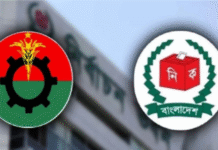Rivers swell, further inundate 3 districts

The water level of Teesta, Monu and Dhalai has continued to rise, further inundating the north and north-eastern regions of the country
Five days of heavy rainfall and the onrush of upstream water have caused the flood situation in Bangladesh to worsen, as the rivers continue to swell and inundate the districts in north and north-eastern regions.
On Saturday morning, the water of Teesta River was flowing 53cm above the danger level.
In Lalmonirhat, thousands of people in several upazilas were stranded due to the water entering their homes and flooding the roads.
All 44 sluice gates of the Teesta Barrage were opened to control the onrush of floodwater, but the water level has continued to rise.
Local administration and Lalmonirhat Water Development Board have cautioned people from Hatibandha, Kaliganj, Aditmari and Lalmonirhat Sadar upazilas to leave their villages.
Water Development Board Deputy Assistant Engineer, Aminur Rashid, confirmed the facts to Dhaka Tribune.
He said: “There is a possibility the water level might continue to rise for the next 4-5 days. If necessary, the flood bypass at the north of Teesta Barrage, at Goddamari union under Hatibandha, will need to be cut off to keep the water flow normal.”
Additional Deputy Commissioner (ADC) (Revenue) of Lalmonirhat district administration, Ahsan Habib, said they are constantly monitoring the situation at Goddamari.
“All people from that area have been asked to leave their villages,” he said.
The district administration has taken full preparations to ensure safety for the flood-affected villagers, he said. “We are providing aid to them. There have been no reports of casualties yet.”
Meanwhile, Lalmonirhat 1 MP and former state minister Lt (retd) Motahar Hosssain said six unions – including Dohogram in Patgram and Goddamari in Hatibandha – have become seriously affected by the floods.

The onrush of Dhalai water has washed out 20ft of an embankment, inundating Rampasha village in Kamalganj upazila on Saturday, July 13, 2019 | Dhaka Tribune
“Three unions under Kaliganj, three unions under Sadar, and one union under Aditmari upazilas – all on the banks of Teesta River – have become submerged under water,” he said.
“Thousands of suffering people have become trapped by the water,” he said. “District administration has been instructed to stand by the people, in these dire times.”
In Nilphamari, around 15 chars and villages in Dimla and Jaldhaka upazilas have become submerged under water, marooning 75,000 people.
Chhatnai union Chairman Abdul Latif said the flood has caused 1,140 families from Chhatnai union to be completely stranded, as the roads have become submerged. The villagers are now stacking sacks of sand on the roads to prevent more water from entering their houses.
Water Development Board Deputy Assistant Engineer, Hafizul Haque said: “We have heard the Banpara dam broke down by 60 metres. But we are trying to prevent any further breakdowns.”
He said a plan to protect this dam from future damage will be effective from September.
Meanwhile, Dimla Upazila Nirbahi Officer (UNO) Nazmun Nahar said: “50 metric tonnes of rice, Tk50,000 and 500 packets of dried food have been allocated for the flood-affected people of Dimla. We still have not issued red alerts in many villages but if needed, we are prepared to provide adequate relief in the areas where people are stranded.”
Heavy rainfall and onrush of water from the upstream have also swelled the rivers Monu and Dhalai in Moulvibazar, and they are flowing over the danger level.
The onrush of Dhalai water has washed out 20ft of an embankment, inundating Rampasha village in Kamalganj upazila on Saturday.
Over 5,000 residents got stranded due to flood, our correspondent reported.
Executive Engineer Ranendra Shankar Chakrabarty of the district Water Development Board said they were monitoring the situation.
He said Monu and Dhalai crossed danger level from early Saturday and were flowing 35cm, and 33cm, respectively, above the danger level from 12:30pm onwards.
However, when this report was written, waters of the rivers have started to recede, he added.









